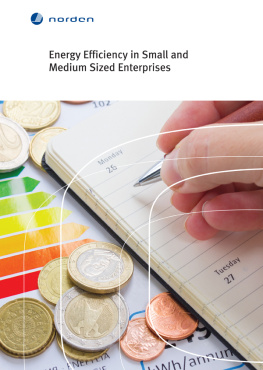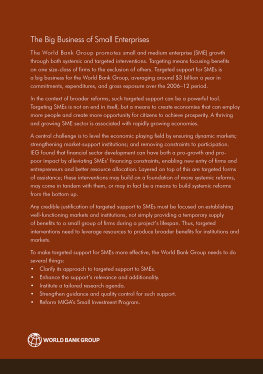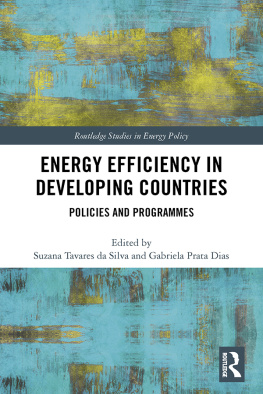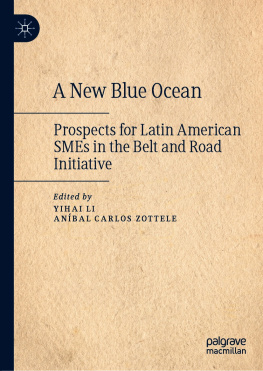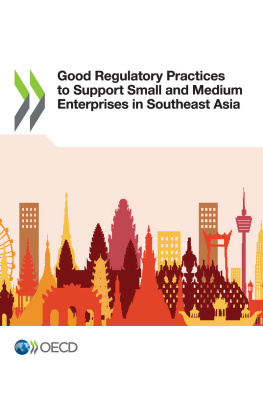
Energy Efficiency in Small and Medium Sized Enterprises
Marika Brckl, Julia Illman, Laura Oja, Iivo Vehvilinen, Gaia Consulting Ltd.
TemaNord 2014:510
Energy Efficiency in Small and Medium Sized Enterprises
Marika Brckl, Julia Illman, Laura Oja, Iivo Vehvilinen, Gaia Consulting Ltd.
ePub produktion: Rosendahls - BookPartnerMedia
ISBN 978-92-893-2718-3
http://dx.doi.org/10.6027/TN2014-510
TemaNord 2014:510
ISSN 0908-6692
Nordic Council of Ministers 2014
Layout: Hanne Lebech
Cover photo: ImageSelect
Print: Rosendahls-Schultz Grafisk
Printed in Denmark

This publication has been published with financial support by the Nordic Council of Ministers. However, the contents of this publication do not necessarily reflect the views, policies or recommendations of the Nordic Council of Ministers.
www.norden.org/en/publications

Nordic co-operation
Nordic co-operation is one of the worlds most extensive forms of regional collaboration, involving Denmark, Finland, Iceland, Norway, Sweden, and the Faroe Islands, Greenland, and land.
Nordic co-operation has firm traditions in politics, the economy, and culture. It plays an important role in European and international collaboration, and aims at creating a strong Nordic community in a strong Europe.
Nordic co-operation seeks to safeguard Nordic and regional interests and principles in the global community. Common Nordic values help the region solidify its position as one of the worlds most innovative and competitive.
Nordic Council of Ministers
Ved Stranden 18
DK-1061 Copenhagen K
Phone (+45) 3396 0200
www.norden.org
The European Unions Directive 2012/27/EU on energy efficiency, which was adopted in October 2012, sets requirements for small and medium sized enterprises (SMEs). The Directive obliges Member States to develop programmes to encourage SMEs to improve their energy efficiency by implementing energy audits and the recommendations that stem from these audits. To support the Nordic countries efforts to implement the part of the Directive that is aimed at SMEs, a joint Nordic project was initiated by the Nordic Committee on Energy under the Nordic Council of Ministers.
The aim was to generate knowledge about barriers to energy efficiency in SMEs, and propose uniform solutions for energy management, including how to encourage individual companies to implement appropriate energy efficiency measures. A combination of different methods including desk study, interviews, and workshops were used in order to gather relevant information about the Nordic SME sectors current energy consumption and existing policy instruments and to generate recommendations to support implementation of the Directive.
The study concludes that although the consumption per company is often low, the SME sector as a whole consumes a significant amount of energy. With the right measures, SMEs can also contribute to energy efficiency improvements. SMEs cannot be effectively targeted with solely uniform solutions even though many of them face similar barriers. The current policy instruments include many elements that could help encourage SMEs, but more emphasis needs to be placed on sharing information and best practices and making sure that SMEs actually implement energy efficiency improvements. Getting started with the energy management should be made as easy as possible for the companies. Energy efficiency guidance of SMEs should be implemented into existing processes.
It is recommended that direct, targeted, and tailored information should be provided to a correct person in the SMEs at a correct time and form. Energy efficiency guidance should be incorporated into existing encounters with SMEs. Authorities, associations, and existing networks should be better organised to share best practices and information with each other and with SMEs. It should also be ensured that no artificial barriers exist for SMEs to apply the existing policy instruments.
Among the recommendations presented in this study, the following are suggested for implementation at the Nordic level:
- Designing a concept for an energy efficiency award campaign.
- Developing a Nordic benchmarking tool on energy consumption levels and savings potential.
- Reviewing existing calculation methods for energy saving potential and establishing a standard to be spread as best practice among financing institutions.
- Developing a joint Nordic database for energy audit data this could potentially be combined with the benchmarking tool.
These measures would best support national level actors in each country to implement the Directive. The effective organisation of other measures between national organisations and municipal/regional/industry association levels will differ in each Nordic country. It is suggested that national energy agencies review the recommendations and outline a suggestion to be confirmed with relevant actors on the roles that each party should take, including who should carry responsibility for each recommendation.
While this study has identified numerous barriers to implementing the Directive, the positive outcome is that many good practices already exist. Furthermore, all parties involved in this study, which also include those stakeholders key to implementing the recommendations, were motivated to improve energy efficiency among SMEs. The potential has been widely recognised, now it is just a question of taking action.
The European Unions Directive 2012/27/EU on energy efficiency was adopted in October 2012. The Directive has set requirements concerning small and medium sized enterprises (SMEs), among other requirements. The Directive obliges Member States to develop programmes to encourage SMEs to improve their energy efficiency by implementing energy audits and the recommendations that stem from these audits. The directive allows the establishment of support schemes for SMEs and calls for highlighting concrete examples of how energy management systems could help their businesses.
Of all major sectors consuming energy, SMEs are the most challenging for policy makers. Energy consumption per company is typically small, and energy is not a priority for most of the SMEs. Unlike larger energy intensive companies, SMEs seldom have large enough financial incentives or possibilities in practice to use the companys own resources to plan and implement energy efficiency activities. SMEs are not as homogenous a sector as households. Targeting energy efficiency policy measures is difficult as the business activities, location, and other conditions can vary considerably between SMEs. In most countries, the energy consumption of SMEs is not even known in any sufficient granularity.
It is also challenging to get a comprehensive view on what actions should be taken to best serve SMEs. People with practical first-hand knowledge on the problems of SMEs are hard to find and activate to share their knowledge, as they must focus their resources on running their own companies. The large number of subsectors amplifies the challenges as the problems of one SME are not necessarily applicable to others even in the same sector or location.
Currently, there are some differences in the ways that Nordic Countries have addressed energy efficiency development in SMEs. For example, in Finland and Sweden, SMEs can receive support to conduct energy audits. In Norway, a benchmark solution has been developed for companies to post their data on energy consumption and production and to compare themselves with others in the same industry. Although there are some differences in the Nordic countries in how SMEs take on energy efficiency improvement, the shared cultural background and common welfare economies provide a good starting point for a joint Nordic effort to tackle the challenges of energy efficiency.
Next page
